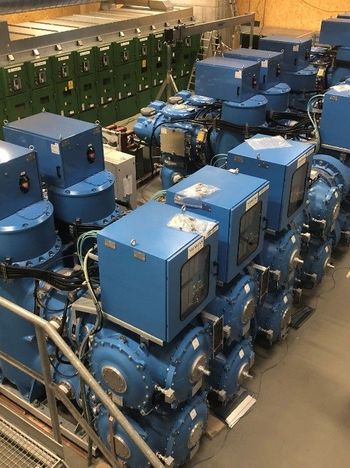Power System Operation - New Challenges and the Continuous Need for New Solutions ensuring a Future without Routine
One thing we can be sure of is that the world continues to change. Climate change, political and economic contexts, new realities in the social scenario, everything seems to contribute to questioning the term "transition" as a situation with no end date.

By Yaran Li (CN), WG C2.45 Convenor, Greg Hesse (AU), WG C2.44 Convenor and Jayme Darriba Macêdo (BR) SC.C2 Chair
On the one hand, in the past we have already questioned the adequacy of the term "energy transition" for this process that electrical systems have been experiencing due to the difficulty in seeing the perspective of establishing a new equilibrium situation.
On the other hand, the consequences of changes in equipment, systems and processes linked, especially to operation, but to electrical systems in general, cause new issues that lead to the perpetuation of evolution.
Fortunately, we note that different subgroups of the technical community, including the operations community, have been generating, with great speed, new knowledge to face the challenges.
While innovative thinking, forward planning and investment in new technologies, processes and system will be critical to a successful energy transition, it is also the case that power system operators remain responsible for maintaining a safe, secure, reliable and affordable electricity supply today. We do not have the luxury of building a whole new power system in parallel with the existing one and then transferring over. As some have described the challenge – we have to rebuild the plane while we are still flying it!
In addition to the diverse development of new knowledge throughout the CIGRE Study Committee C2 community during 2023, some important actions concentrated in active Working Groups were verified and their dissemination and application remain at the root of our objectives. And the perception of the need to create new Working Groups that are now beginning their activities was no different from the recent past.
The irreversible energy transition calls for the creation of the Working Group C2.45, titled “Estimation, evaluation and provision of power system inertia in networks with a high share of renewable generation”, which endeavors to address the emerging power system planning and operating issues due to the lack of inertia.
In the conventional power grids, fossil fueled synchronous generators are the essential source to provide inertia. However, for typical renewable generators, the frequency is decoupled from the main grid due to the interface of power electronics devices, thus providing zero or low inertia to the power system. As a result, the increasing decommissioning of synchronous generators and the accelerating penetration of asynchronous generators are potentially creating inertia shortfalls for the power system, which progressively and fundamentally alters power system frequency dynamics.
Relevant investigations have been undertaken in the previous CIGRE Working Groups, most notably:
- TB 851: Impact of High Penetration of Inverter-based Generation on System Inertia of Networks
- TB 885: Guide on the Assessment, Specification and Design of Synchronous Condenser for Power System with Predominance of Low or Zero Inertia Generators
In addition, power system operators, jurisdictional planning bodies and regulatory commissions in many countries have been actively investigating methodologies to evaluate system inertia and efficient solutions to address the potential shortfalls, which are formulated as national-wide rules to regulate the system inertia above the prescribed level. Industry has also been collaborating with academia to undertake several trials that will inform inertia capabilities of the key innovative technologies, such as grid-forming inverters with voltage control capability and battery energy storage systems (BESS).
Further focus of the Working Group will be specifically on the underlying principle of inertia response for networks with a high penetration of renewables and the effective scheme of managing the inertia from the perspective of interconnected power systems. Therefore, the purpose of this working group is to investigate new definitions for power system inertia in the current context, and then identify the methodologies and requirements to estimate, assess and improve the power system inertia, which ultimately facilitates the maintenance of frequency stability throughout the power system transformation. The working group will also serve as a platform for the dissemination of innovative technologies, on-site experiences and knowledge sharing.
To advise philosophies on inertia management of interconnected power systems with a high share of renewable generation, inclusive of the technical aspects such as estimation, assessment and provision of power system inertia, the content of the work includes but is not limited to the following categories:
- Review previous CIGRE work relating to the topic (e.g. TB 851 and TB 885) and the connection with other work in this domain (e.g. inertia studies published by EPRI, ENTSO-E and NREL).
- Survey international experiences regarding inertia management of power systems.
- Revisit definitions and underlying principles
- Develop methodologies to estimate power system inertia
- Provide insights on effectively evaluating power system inertia
- Identify possible inertia remediation schemes to improve power system inertia
- Formulate the framework to guide the management of power system inertia
- Study use cases
The integration and delivery of the knowledge in a concise and compact Technical Brochure is anticipated to assist power system operators in maintaining frequency stability of power systems, original equipment manufacturers in designing the infrastructure with compliant inertial response, and stakeholders in understanding the underlying principles thus determining the investment in the most secure and economic power system services.

The Working Group C2.45 was approved in October 2023, and it has been undergoing the process of recruiting members by National Committees and Study Committees. For the last couple of weeks, several professional experts have already been nominated from many different backgrounds and countries. Their expertise and experience will significantly contribute to the Working Group.
The reduced availability of the traditional synchronous generators not only reduces inertia, but also reduces fault current, voltage control, system strength etc. Reduced fault current in the system can impact the performance of protection systems and system standards. It can also result in adverse and unwanted interactions between control systems of Inverter Based Resources (IBR) and lead to power system instability. With less voltage control capabilities, the complexities of the steady state and dynamic voltage control increases.
The increased installation of distribution connected IBR such as roof-top photo-voltaic (PV) systems reduce the operational demand to be supplied from the transmission grid during high generation from roof-top PV systems. The low operational demand impacts the effectiveness of emergency control schemes such as load shedding and measures that are often exercised to safeguard the power system during extreme events.
Previous CIGRE Working Groups have explored specific features of the energy transition, such as the effect of reducing power system inertia that is occurring as existing synchronous generator are replaced by IBR. It is true that investment in new sources of the required power system capabilities such as frequency control, voltage control and fault current contribution will ultimately allow the transition to occur. However, the power system must continue to be operated minute by minute, every day into the future.
For decades power systems have developed with the goal to satisfactorily cope with peak operating conditions such as maximum demand or high fault levels. While not desirable it was almost always possible for the system operator to interrupt some level of customer demand to manage a peak demand condition on the power system. The same sorts of operating strategies that successfully manage peak power system operating conditions are unlikely to be suitable to manage the opposite conditions of low demand, low inertia, low fault level etc.
With this background a new Working Group C2.44 “Operational strategies to manage power system minimum operating conditions” has been established. The goal of the Working Group is to identify remedial actions and operating strategies available to power system operators to manage and mitigate the unique risks that extreme minimum operating conditions present.
The Working Group C2.44 was approved in June 2023 and has been recruiting members from National Committees, including NGN members. The Working Group is now commencing its work and establishing a forward plan of activities. This includes an important survey to identify the current state of play around the world in understanding and managing extreme power system minimum operating conditions.
We follow our path in line with the perspectives and strategic technical directions of CIGRE as a whole and our C2 Study Committee in particular, seeking to anticipate and explain challenges, adding contributors and certain that, always as a team, we create knowledge to be disseminated, generating value to the well-being of the global community.
Thumbnail credit: DKosig on iStock



